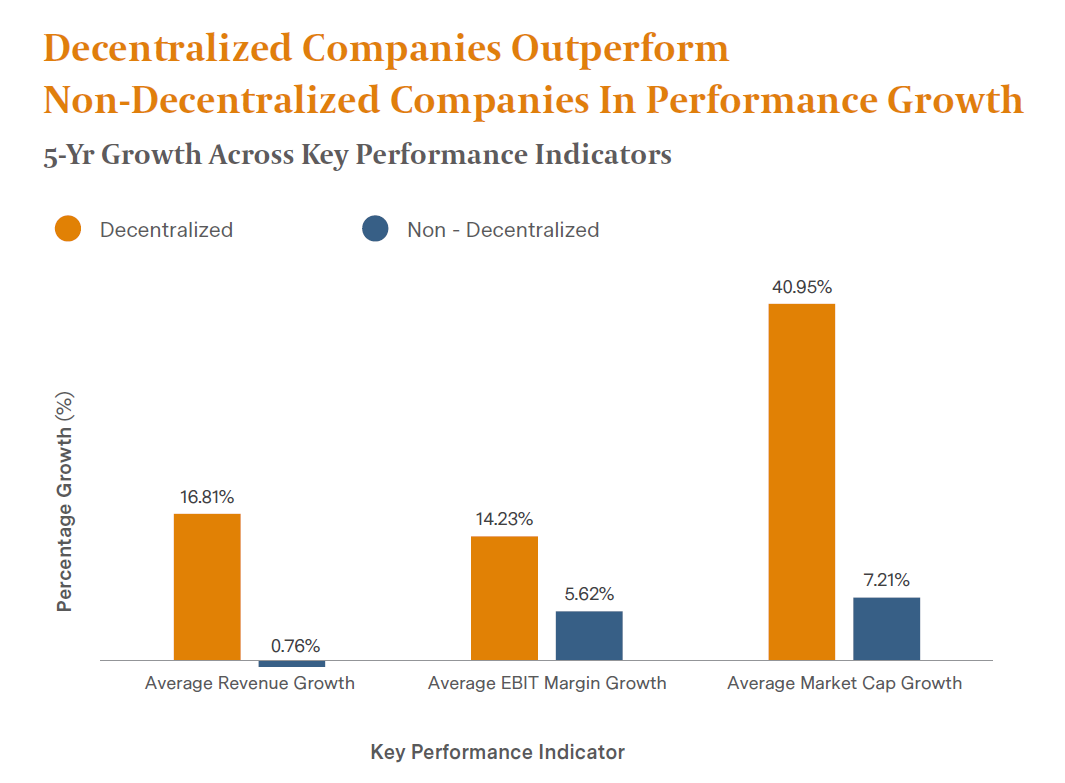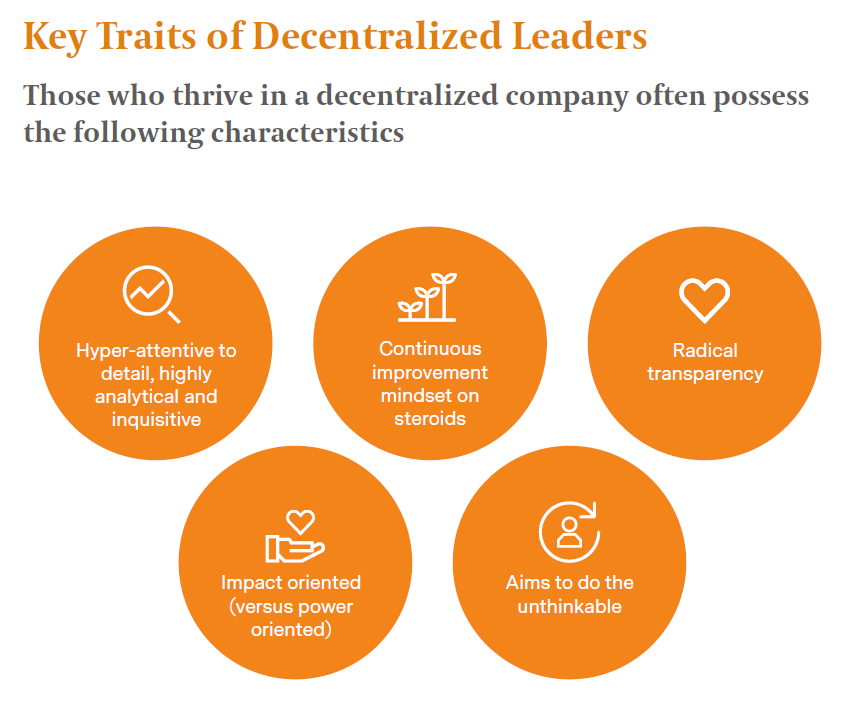Decentralized machinery companies have a proven record of high performance— consistently beating their non-decentralized peers, according to key performance indicators. Based on our study of 28 global machinery companies and their performance over 5 years, 100 percent of decentralized companies had positive market-cap growth, while only 33 percent of the non-decentralized companies experienced the same. Not surprisingly, decentralized organizations also outperformed their peers in terms of average revenue growth and EBIT margin growth over this time period.

Defining Decentralization
Decentralization is an organizational structure that maintains independent business units (to the degree possible) under a single corporate umbrella. Each business unit functions as a stand-alone company with a President, who acts very similar to a CEO and the businesses are as independent as possible.
To find out what is behind decentralized companies’ consistent success, we interviewed CEOs and company presidents of publicly listed industrial
companies. We found there are three main drivers of decentralized companies’ performance: a common language, leaders with an ownership mindset, and a culture that rejects the status quo.
Talk that Talk: How a Common Language Translates Across Businesses
Decentralized companies talk about problems and opportunities in the same way—regardless of how dissimilar their businesses are. That means if a leader runs a health business and another executive runs a manufacturing business they can understand each other’s challenges and learn from the other because of the shared language. Often stemming from the common language is a shared business system—the tools and processes used by everyone, regardless of where they sit in the company.
There is extensive training and indoctrination in using the business system, though this learning comes while on the job, not by sitting through a training course. Leaders in decentralized companies with clear and developed operating and capital allocation systems are constantly teaching; even performance reviews are often structured in that way. The focus is on how a more seasoned manager can teach others how to look at problems differently and to dig down to the
root cause of any issue. “It’s not training; it’s doing,” a CEO of an industrial manufacturing company said. “If you are new, you get a lot of help from your peers—with the understanding that this isn’t up for negotiation.”
An executive who has experience working in both decentralized and centralized environments noted that this approach is highly effective and gives employees a an understanding of every nook and cranny of the business, which is important since decentralized companies expect executives to be just as comfortable on
a factory floor as a corner office. “When a division president was new, he or she would go work the line for a week, working from 7 a.m. to 7 p.m., to understand the company’s operating system.” he explained. “Everyone was indoctrinated in that way.”
In a decentralized company, senior leaders do not impose functions, decisions, or central costs on its operating companies. For example, many ,of the companies we analyzed did not have one common enterprise resource planning (ERP) system because it can force common processes that are not ideal for all of the various businesses. The cost/benefit is not there, and it would be an act of centralization.
Who Thrives in a Decentralized Company?
Decentralized companies attract a certain type of leader—particularly one with an ownership mindset. “Here’s the test: Pick PowerPoint or Excel. If you pick PowerPoint, the interview is over,” a president of a manufacturer joked. “We look for analytical and competitive people who can roll up their sleeves and go from the boardroom to the shop room floor.”
Many of the executives we spoke to pointed to the following characteristics in employees who thrive in a decentralized company.

A decentralized company needs leaders who are comfortable being coaches, teachers, and pressure-testers, those who believe in the operating system and never stop practicing it. This type of dedication to facts and details creates a culture that is more fact-based, less opinion-based, and tests validity of details, forcing intellectual honesty. However, finding this type of talent can be challenging. A senior vice president of an industrial conglomerate used a racecar driver analogy to sum up the differences between centralized and decentralized leaders. “In a centralized company, you’re the star and you drive the car. In a decentralized company, you’re not just the driver; you are responsible for the whole pit team. You have to build the car and maintain it,” he explained.
Executives commented that when they find people who are hungry for more ownership responsibilities, a decentralized structure is often what they have been dreaming of. “When we go to recruit with this model, people are dying to do it. They’re sick of sitting in boardrooms with 15 people, and no one in the room can fully make a decision,” said the president of a manufacturer. When you do find the right talent, decentralized companies can create a strong pipeline for leadership succession planning. These companies train leaders from a low P&L responsibility to grow to higher ones in an environment where they are tested constantly and have been trained to act like business owners.
In addition to a certain type of senior leader, decentralized companies also need a CEO with the right mentality—one who is comfortable being very accessible to employees, embraces the teaching model, and who doesn’t expect a dog and pony show at meetings. An executive we spoke with explained that in decentralized companies, there is not a two-week scramble to assemble information when the CEO comes to visit. Everyone already knows what he or she wants to talk about because of the streamlined set of metrics and communication tools decentralized companies have. CEOs at decentralized companies also go through teaching by doing and therefore indoctrinate a common language. They have the tendency to behave as equals, rather than as the most powerful and inaccessible leader in the company.
A Culture of Discontent (in a Good Way)
Leaders who truly feel ownership of their businesses create a culture where performance can soar with fewer restraints. One of the key aspects of the culture at a decentralized company is that there is less internal politics, largely because business leaders can make decisions with a high degree of autonomy. “My observation is there is a lot more frustration in a centralized company. They have to go to battle internally all the time to get things done and get sign off from many people,” one senior vice president of an industrial conglomerate who has worked in centralized and decentralized companies noted. “At a decentralized company, you still need to justify what you want to do, but it is simpler
and not political.”
There is also a high level of trust within the organization, giving leaders the freedom to take risks and make mistakes—although how they communicate struggles and solutions matters. If you share information, then you succeed and fail together; if you hide crucial data, then you fail alone. “Trust is fundamental to why we [decentralized companies] are successful,” said an industrial manufacturing company CEO. “If you fail once, fine. If you fail a second time,
I have to ask if you’re the right person for the job.”
A general manager at a large industrial conglomerate agreed that decentralized companies give you space to try things out. “You could argue that if my boss were approving my decisions, I might make fewer mistakes, but as long as you can learn and recover from these mistakes, you’re creating a better leader,” he said.
There is also a high level of transparency among business units, and it’s clear to everyone which businesses are performing and who is responsible for successes—and failures. “It’s easier to gauge individual performance in a decentralized company and take corrective action,” a senior vice president of an industrial conglomerate said. “In a matrixed centralized environment, because accountability can be shared, mediocre people can survive for a very long time.”
Moving From Centralized to Decentralized: Is It Possible and Is It Worth It?
Most of the executives we spoke with agreed that centralized companies could decentralize if they were truly committed to it but noted it would be extremely difficult to make that transition since it requires a culture and people shift. Most companies have a creeping tendency to want to centralize, as it allows them to save money in the short term and maintain profitability.
It is also important to remember that businesses cannot decentralize without keeping transparency and strong business governance at their core. “If you are not fully committed [to transparency and good governance], you could create a mess,” a president of a manufacturer said. “You end up at the whim of your general managers—and your success is dependent on how good and truthful those managers are.”
The CEO of an industrial manufacturing company said that a centralized company looking to make this scale of change would also need to exercise extreme patience. “You have to be willing to simplify things and free the organization from the shackles of bureaucracy, along with the courage and conviction to know things can’t change in 12 months,” he noted. “I can’t just wake up and run a marathon. But I can train and measure progress—it’s the same idea.”
Examples of companies that have done this include Crane Co., Colfax Corp., and Marmon Holdings, who all made this move by hiring a number of employees from well-established decentralized companies, such as Danaher Corp. and ITW Inc.
Some industrial conglomerates are making moves toward decentralization, splitting up into smaller, separate entities such as General Electic Co., United Technologies Corp., Atlas Copco, Metso Oyj, and Ingersoll Rand Inc. One of the appealing elements of decentralizing is that mergers and acquisitions and divestitures are much easier. You can add companies and cut your losses more easily when they are stand-alone businesses and not interwoven with other business units.
However, decentralization is not the Holy Grail for all companies. More capital- intensive business models tend to have less of a need or opportunity for this type of model, and there are key benefits to centralization as well. The leaders within centralized companies have deep and narrow expertise, are adept at driving consensus and alignment among their peers, and can develop insightful area- specific strategies. In addition, there may be industries, markets, and situations where centralization makes the most sense. Decentralization is not right for every company. At a decentralized company, leaders are running multiple functions and need to know how they play together. Whether decentralization or centralization is right for your company ultimately depends on your value creation strategy.
One Win Is Never Enough: Pushing Performance Limits
Decentralization is a conscious and consistent choice that resists and defies the centralization logic. Leaders of these companies believe this structure delivers better returns and accept that this independent management style is less about collaboration and influencing—competencies so valued in centralized and matrixed organizations. They also accept there will be a certain duplication of costs, with the belief their culture and philosophy will more than offset them.
For companies that have embraced a decentralized model, there are clear benefits: highly accountable leaders who are act like business owners and drive a culture of winning throughout the company. It is this ownership mentality that creates focus, accountability, and motivation that delivers high returns for investors, outweighing the cost duplication that can result in this type of structure.
Not every leader will thrive in this type of environment, but those who do can take their skills—and their organizations—to new heights. While many
companies mark growth and success by beating the previous year’s returns or achieving 10 percent EBIT, decentralized companies do not have the same level of contentment, and typically reach more than 20 percent EBIT. “You recognize what you have achieved, and then you push your organization to go further,” explained a president of a utility sensor company. “There is never a limit. No matter how profitable you are, you never stop.”
Note: This article originally appeared in Industry Week.





